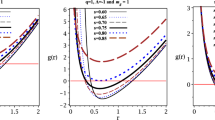Abstract
This paper assesses the thermodynamic properties of classical Schwarzschild Black Holes. We review the thermodynamic cycle in the Geroch gedanken experiment in its relation to the classical limit of Hawking temperature, and conclude that a minimal distance requirement for pouring out radiation onto the event horizon in the gedanken experiment implies the assignment of temperature \({{T}_{{{\text{BH}}}}} \to 0\) asympotically rather than exact absolute zero \(K\): a classical Schwarzschild horizon is an asymptotically zero Kelvin mechanical thermostat operated at asymptotically unit efficiency. We classify the gravitational heat pumping work done by horizon surface gravitation as perpetual motion of the third kind. The latter property does not, however, violate the Second Law, because it is impossible to extract gravitational energy from a classical Schwarzschild Black Hole in quasi-static equilibrium. The classical limit of the Bekenstein–Hawking (quantum) entropy formula is divergent as \({{S}_{{{\text{BH}}}}} \to \infty \), yet since \(\delta {{S}_{{{\text{BH}}}}} \to 0\) the Nernst statement of the Third Law is not violated. Aided by the Bekenstein bound, it is shown that the Generalized Second Law persists to hold in its classical limit, when applied to the joint system of Schwarzschild Black Hole and infalling radiation gas in the Geroch gedanken experiment. The minimal horizon distance \(\delta r\) is inferred from the Bekenstein bound, and ensures that the Geroch thermodynamic cycle be processed reversibly. The overall conclusion is that the laws of thermodynamics are not transcended by classical Schwarzschild Black Holes, despite their extremal thermodynamic properties.


Similar content being viewed by others
Notes
Furthermore, equating the First Law of Thermodynamics (δQ = TdS) with the First Law of Black Hole Mechanics (dM = \(\frac{1}{8\pi}\kappa dA\)), Bekenstein arrived at what he called a characteristic Black Hole temperature \(T_{BH} = \frac{1}{8\pi}\frac{\kappa}{dS/dA} = \frac{1}{8\pi\eta}\kappa l_{p}^{2}\) [15, 20].
The validity of the bound has been disputed over decades, until Casini gave a formal proof in the framework of quantum field theory. By taking differences of expecation values for energy density and for von Neumann entropy in an excited state as compared to their expectation values in the vacuum ground state, ultraviolet divergences are avoided. He makes sense of the characteristic length R by the generator operator of the relativistic Lorentz boost [31].
Bekenstein’s calculation of thermodynamic efficiency (as summarized in Subsection 2.2) also neglects the fact that upon increase in Black Hole mass by \(\Delta M\), there is a slightly greater cost in work \({{\tilde {W}}_{2}}\) = \((m\;\, - \;\,\Delta m)Z\;\, \to \;\,(m\;\, - \;\,\Delta m)Z\;\, \times \) \(\left( {1 + \tfrac{{2G[M + (m - \Delta m)Z]}}{{2GM + \delta r}}} \right)\) that needs be expended in order to haul back up the box with the remainder mass \(m - \Delta m\) from \({{r}_{S}} + \delta r\) back “to infinity” after having poured out the radiation \(\Delta m\) onto the horizon, accounting for the increased Schwarzschild potential \(V(r) \to \tilde {V}(r) = - \tfrac{{2G(M + \Delta m{\kern 1pt} ')}}{r}\) against which the box is lifted. An updated efficiency \(\mu \) treatment goes beyond the scope of this work, though the overall effect is that it drops further down below unity.
REFERENCES
S. W. Hawking, Nature (London, U.K.) 248, 30 (1974).
D. Christodoulou, Phys. Rev. Lett. 25, 1596 (1970).
D. Christodoulou and R. Ruffini, Phys. Rev. D 4, 3552 (1971).
S. W. Hawking, Phys. Rev. Lett. 26, 1344 (1971).
R. Penrose and R. M. Floyd, Nat. Phys. Sci. 229, 177 (1971).
Y. B. Zel’dovich, JETP Lett. 14, 180 (1971).
J. D. Bekenstein, Phys. Today 33, 24 (1980).
S. W. Hawking, A Brief History of Time. From the Big Bang to Black Holes (Bantam, London, 1988).
D. N. Page, New J. Phys. 7, 203 (2005); hep-th/0409024.
C. Misner, Bull. Am. Phys. Soc. 17, 472 (1972).
A. A. Starobinskii, Sov. Phys. JETP 37, 28 (1973).
W. Unruh, Phys. Rev. Lett. 31, 1265 (1973).
W. G. Unruh, Phys. Rev. D 10, 3194 (1974).
J. D. Bekenstein, Nuovo Cim. Lett. 4, 737 (1972).
J. D. Bekenstein, Phys. Rev. D 7, 2333 (1973).
J. M. Bardeen, B. Carter, and S. W. Hawking, Commun. Math. Phys. 31, 161 (1973).
D. Finkelstein, Phys. Rev. 110, 965 (1958).
S. W. Hawking, Commun. Math. Phys. 25, 152 (1972).
J. D. Bekenstein, Studies History Philos. Mod. Phys. 32, 511 (2001); gr-qc/0009019.
J. D. Bekenstein, Nuovo Cim. Lett. 11, 467 (1974).
R. Geroch, presented at Colloquium at Princeton University, December 1971.
J. D. Bekenstein, Scholarpedia 3, 7374 (2008).
E. Curiel, Preprint (2015).
S. Carlip, Lect. Notes Phys. 769, 89 (2009).
B. Carter, in Black Holes (Les Astres Occlus) (Gordon and Breach Science Publishers, New York, 1973), p. 57.
R. M. Wald, Phys. Rev. D 56, 6467 (1997); arXiv: gr-qc/9704008.
J. D. Bekenstein, Phys. Rev. D 23, 287 (1981).
S. W. Hawking, Phys. Rev. D 13, 191 (1976).
G. W. Gibbons, Nature Phys. Sci. 240, 77 (1972).
W. G. Unruh and R. M. Wald, Phys. Rev. D 25, 942 (1982).
H. Casini, Classical and Quantum Gravity, 25 (20), 20502 (2008); doi: 10.1088/0264-9381/25/20/205021.
H. J. Bremermann, Quantum Noise and Information (5th Berkeley Symposium on Mathematical Statistics and Probability), (Univ. of California Press, Berkeley, California, 1965).
ACKNOWLEDGMENTS
The author is grateful to O. Maroney for discussions on entropy and the Second Law in thermodynamics, to R. Ruffini on the irreducible mass and irreversible transformations of “No Hair” Black Holes, and to G.V. Vereshchagin for pointing the author’s attention to the Geroch gedanken experiment.
Funding
The work of K. M. is supported by the Klaus Tschira Foundation.
Author information
Authors and Affiliations
Corresponding author
Additional information
Paper presented at the Fourth Zeldovich meeting, an international conference in honor of Ya.B. Zeldovich held in Minsk, Belarus, on September 7–11, 2020. Published by the recommendation of the special editors: S.Ya. Kilin, R. Ruffini, and G.V. Vereshchagin.
Rights and permissions
About this article
Cite this article
Maltsev, K. Thermodynamics of Сlassical Schwarzschild Black Holes. Astron. Rep. 65, 976–984 (2021). https://doi.org/10.1134/S1063772921100218
Received:
Revised:
Accepted:
Published:
Issue Date:
DOI: https://doi.org/10.1134/S1063772921100218




